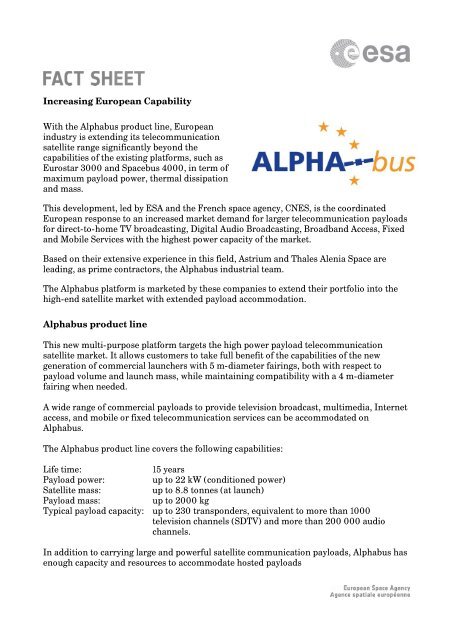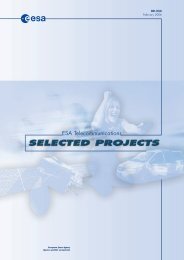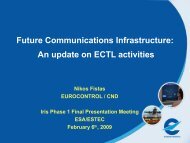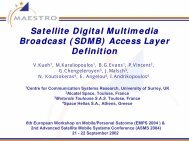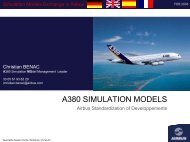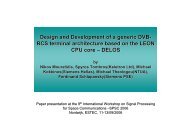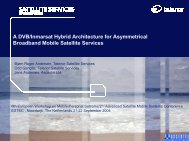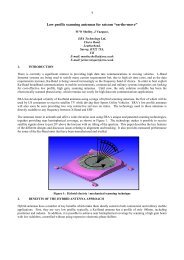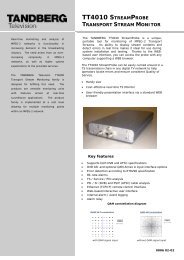Alphabus fact sheet (PDF) - ESA Telecommunications
Alphabus fact sheet (PDF) - ESA Telecommunications
Alphabus fact sheet (PDF) - ESA Telecommunications
You also want an ePaper? Increase the reach of your titles
YUMPU automatically turns print PDFs into web optimized ePapers that Google loves.
Increasing European Capability<br />
With the <strong>Alphabus</strong> product line, European<br />
industry is extending its telecommunication<br />
satellite range significantly beyond the<br />
capabilities of the existing platforms, such as<br />
Eurostar 3000 and Spacebus 4000, in term of<br />
maximum payload power, thermal dissipation<br />
and mass.<br />
This development, led by <strong>ESA</strong> and the French space agency, CNES, is the coordinated<br />
European response to an increased market demand for larger telecommunication payloads<br />
for direct-to-home TV broadcasting, Digital Audio Broadcasting, Broadband Access, Fixed<br />
and Mobile Services with the highest power capacity of the market.<br />
Based on their extensive experience in this field, Astrium and Thales Alenia Space are<br />
leading, as prime contractors, the <strong>Alphabus</strong> industrial team.<br />
The <strong>Alphabus</strong> platform is marketed by these companies to extend their portfolio into the<br />
high-end satellite market with extended payload accommodation.<br />
<strong>Alphabus</strong> product line<br />
This new multi-purpose platform targets the high power payload telecommunication<br />
satellite market. It allows customers to take full benefit of the capabilities of the new<br />
generation of commercial launchers with 5 m-diameter fairings, both with respect to<br />
payload volume and launch mass, while maintaining compatibility with a 4 m-diameter<br />
fairing when needed.<br />
A wide range of commercial payloads to provide television broadcast, multimedia, Internet<br />
access, and mobile or fixed telecommunication services can be accommodated on<br />
<strong>Alphabus</strong>.<br />
The <strong>Alphabus</strong> product line covers the following capabilities:<br />
Life time:<br />
15 years<br />
Payload power:<br />
up to 22 kW (conditioned power)<br />
Satellite mass:<br />
up to 8.8 tonnes (at launch)<br />
Payload mass:<br />
up to 2000 kg<br />
Typical payload capacity: up to 230 transponders, equivalent to more than 1000<br />
television channels (SDTV) and more than 200 000 audio<br />
channels.<br />
In addition to carrying large and powerful satellite communication payloads, <strong>Alphabus</strong> has<br />
enough capacity and resources to accommodate hosted payloads
<strong>Alphabus</strong> Product line Key Features<br />
<br />
<br />
<br />
<br />
Structure<br />
o Spin-formed carbon fibre central<br />
tube and additional carbon and<br />
aluminium panels<br />
o Cross section: 2800 x 2490 mm<br />
o Launcher Interface: 1666 mm<br />
Modular concept<br />
o Antenna module for easier<br />
antenna accommodation and<br />
efficient assembly and test<br />
Attitude and orbit control<br />
o Gyros<br />
o Star and Sun sensors<br />
o Reaction wheels<br />
Data handling through 1553 bus<br />
for payload control<br />
Chemical propulsion<br />
o Apogee engine and 16 thrusters<br />
o 2 propellant tanks (with up to<br />
4200 kg of bi-propellants)<br />
o Helium tanks (3 x 90 litres)<br />
Electrical propulsion<br />
o Xenon tanks (max. 350 kg)<br />
o PPS 1350 thrusters on<br />
orientation mechanisms<br />
Power generation and distribution<br />
o 2 gallium arsenide solar wings<br />
with 4–6 panels<br />
o Power supply and power<br />
distribution offering both 100 V<br />
and 50 V regulated buses<br />
o Modular lithium-ion battery<br />
The <strong>Alphabus</strong> design takes full advantage of the experience gained through the Eurostar<br />
and Spacebus product range, complemented by several new developments to improve the<br />
overall platform performances. As a result, <strong>Alphabus</strong> is a mix of strong heritage and<br />
innovation. The product line relies on qualified European technologies.<br />
European cooperation<br />
<strong>Alphabus</strong> is a cooperative programme between <strong>ESA</strong> and CNES for a new satellite platform<br />
jointly developed by Astrium and Thales Alenia Space.<br />
The development of the product line and production of a first proto-flight <strong>Alphabus</strong> was<br />
performed as a four-party undertaking with a joint <strong>ESA</strong> and CNES customer team and the<br />
prime contractors Astrium and Thales Alenia Space. <strong>Alphabus</strong> was qualified at the end of<br />
2010.<br />
The <strong>Alphabus</strong> proto-flight model will fly within the Alphasat programme with Inmarsat,<br />
allowing an early in-orbit demonstration and validation of the platform. It passed its<br />
acceptance review on 16 June 2011. The Alphasat I-XL launch is scheduled for the first<br />
quarter of 2013 on Ariane 5.<br />
<strong>Alphabus</strong> is now part of the Astrium and Thales Alenia Space industrial product line, and is<br />
being offered on the world market.<br />
<strong>ESA</strong> Media Relations Office<br />
Tel: +33 1 53 69 71 55<br />
Fax: +33 1 53 69 76 90<br />
Email: media@esa.int Last updated: 10 June 2011


